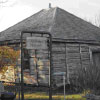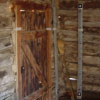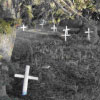Home | The Black Settlements of Western Canada | Black Rural Communities in Saskatchewan and Alberta | Maidstone/Eldon District, Saskatchewan

The text on this page is an excerpt from The Settlement of Oklahoma Blacks in Western Canada,a report prepared by Michael B. Payne, PhD and commissioned by Parks Canada, Department of Canadian Heritage.Dr. Payne is currently Chief Archivist, City of Edmonton Archives.
Maidstone/Eldon District, Saskatchewan
The Black settlement north of Maidstone in the Eldon District can be traced back to at least 1908 and perhaps 1907. This makes it the oldest of the Black group settlements in western Canada, along with Wildwood/Junkins in Alberta, which also dates from 1908. According to the local history of the area, one Samuel Boyd filed on a homestead in 1907 in the district, although little else is known about him. Anderson Harper is often listed as the real founder of the settlement after arriving from Oklahoma to take up a homestead in 1908. The bulk of the community arrived in 1910 and 1911 as individual families and some groups of settlers. In total, roughly 20 families settled in the area, although this figure includes several members of extended families such as the Mayes and Lane families who took up separate homesteads in the area.1
The family histories of these settlers offer an interesting microcosm of western Canadian rural history. The area chosen for settlement was well-wooded, which was good for acquiring firewood and lumber for construction but made clearing the land for crops very difficult. In addition, some of the land was found to be rocky after it was cleared. The soil was a light loam, which limited crops until the use of fertilizers became common. As a result, a number of the initial homesteads were quickly abandoned. For the families that persevered and eventually secured title to their land, the 1920s and 30s were very hard and many left the area in these years. By the 1950s few Black families remained in the district, and according to the local history, George Harvey Mayes was the last of the “Shiloh” people to remain on his farm. He died in 1975 at the age of eighty-one.2 Many members of the community moved to Edmonton or the Battlefords in search of better work prospects, while others left to return to the United States or to move elsewhere in Canada.3

 One
interesting story associated with this community is its struggle to get a
school. By 1913 there were enough families in the area for residents to believe
a school was needed within the community. Petitions to have a school created,
however, were repeatedly rejected by local authorities on a variety of
technicalities, apparently because any new school district would inevitably
include some white families within district boundaries. Appeals to the
Department of Education in Regina also fell on deaf ears for several years, and
the issue was briefly taken up as a political issue by the local MLA, J.P.
Lyle, who noted that “the settlers are considerably worked up about
having to send their children to school with the negroes.” Lyle
eventually came to the view that the Black settlers had cause to be angered by
their treatment, and in 1915 the Department of Education finally intervened and
created a new school district that carefully excluded all white families. For
several years the school remained segregated in practise, but by the 1920s as
Black homestead families left the District and white farmers took up their
lands it was gradually integrated. The Eldon School District remained in place
until 1951 when the district was consolidated and the school was finally closed
in 1959.4
One
interesting story associated with this community is its struggle to get a
school. By 1913 there were enough families in the area for residents to believe
a school was needed within the community. Petitions to have a school created,
however, were repeatedly rejected by local authorities on a variety of
technicalities, apparently because any new school district would inevitably
include some white families within district boundaries. Appeals to the
Department of Education in Regina also fell on deaf ears for several years, and
the issue was briefly taken up as a political issue by the local MLA, J.P.
Lyle, who noted that “the settlers are considerably worked up about
having to send their children to school with the negroes.” Lyle
eventually came to the view that the Black settlers had cause to be angered by
their treatment, and in 1915 the Department of Education finally intervened and
created a new school district that carefully excluded all white families. For
several years the school remained segregated in practise, but by the 1920s as
Black homestead families left the District and white farmers took up their
lands it was gradually integrated. The Eldon School District remained in place
until 1951 when the district was consolidated and the school was finally closed
in 1959.4

 As the local history for the area makes
clear, there are very few surviving physical remains of this community. Most of
the original homestead farms have been sold and absorbed into larger farm
operations. Original farm buildings have been torn down and the old Eldon
schoolhouse and teacherage have both been moved although the buildings were
still in use—albeit much altered—in 1981.5
The main physical evidence of this community is a surviving church and
cemetery. This church, called Shiloh Baptist Church, was established in 1912
and operated until the 1940s, although burials apparently still take place in
its cemetery.6 Some
modest restoration/preservation work has been done on the church and cemetery,
and the site has been recognized by the local municipality as a historic site.7
It has not received provincial designation as yet.
As the local history for the area makes
clear, there are very few surviving physical remains of this community. Most of
the original homestead farms have been sold and absorbed into larger farm
operations. Original farm buildings have been torn down and the old Eldon
schoolhouse and teacherage have both been moved although the buildings were
still in use—albeit much altered—in 1981.5
The main physical evidence of this community is a surviving church and
cemetery. This church, called Shiloh Baptist Church, was established in 1912
and operated until the 1940s, although burials apparently still take place in
its cemetery.6 Some
modest restoration/preservation work has been done on the church and cemetery,
and the site has been recognized by the local municipality as a historic site.7
It has not received provincial designation as yet.
Notes
1 See North of the Gully History Book Committee, North of the Gully (Maidstone: Maidstone Mirror, 1981) pp. 357-77.
2 Ibid. p. 367.
3 There are a number of descendents of these families who have distinguished themselves in various careers. Perhaps the best known is Reuben Mayes, a member of one of the largest families from the Eldon District, who left North Battleford to become a star football player at Washington State University and with the New Orleans Saints and Seattle Seahawks of the National Football League. In 1986 Mayes was voted “Rookie of the Year” in the NFL.
4 The story is covered in detail in Shepard, Deemed Unsuitable, pp.107-11.
5 See North of the Gully, pp. 377-81. Interestingly, this local history does not touch on the struggle to get the school built in the first place.
6 The closing of the church as an active parish in the 1940s reflects the death or departure of most of the original settlers and their children from the district.
7 The work on the church consists primarily of stabilization of the log structure to prevent collapse. New grave markers were added to the cemetery but this work has been criticized as it resulted in the removal of the original and authentic rock grave markers and the substitution of historically inaccurate white-painted wooden crosses on gravesites. See http://www.ucalgary.ca/~dsucha/shiloh.html.



